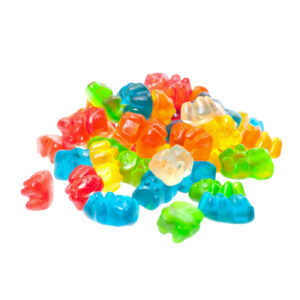4 ways to eliminate tails from your depositing process
posted on 10 March, 2023 by Edward Smagarinsky - Group Product Manager (Mogul)
 In candy production, tails cause product loss and unscheduled downtime, which we estimate at 88 to 123 hours a month on average dependent on production run time. In this blog we analyse the main reasons for tail formation and share insights on how to minimise tails in your candy production process.
In candy production, tails cause product loss and unscheduled downtime, which we estimate at 88 to 123 hours a month on average dependent on production run time. In this blog we analyse the main reasons for tail formation and share insights on how to minimise tails in your candy production process.
Simply put, tails are extra quantities of product that don’t go directly into the mould. Instead, the last small portion of the product stream extends from the depositing nozzle all the way down to the mould and remains there before falling into the tray between moulds. It forms bridges between moulds and sticks to the edge of the starch trays, causing wastage, mess, and disruption to the confectionery production process.
Usually tails are the result of a crystallisation process when the candy mass leaves the pump body via the nozzle plate to be deposited in the tray.
A number of different factors contribute to tailings on the end product. We’ve grouped them into 4 key areas of focus if you’re looking to eliminate tails from your candy production process.
The environment
It’s important to have the minimum amount of air in the depositing area. Ideally this space will be entirely airless so remove or disable any fans, close all the doors and box off the depositing area.
The temperature also plays an important role in minimising tailing in candy manufacturing. Make sure the depositing area is not too cool, and instead aim for humid conditions by closing any large gaps where air could possibly circulate.
The product
There are a few key checks you can make to ensure the candy product is set up in a way that minimises the risk of tails occurring:
1. Check the depositing media with a refractometer and maintain the optimum fluid content according to the established recipe.
2. Check the depositing media has not been recirculating through the kitchen for a lengthy amount of time.
3. Check the depositing media has not been overcooked as it will mean there’s less water content than is required and often result in an undesirable colour change.
The pump
Wear and tear on the pump can lead to an increase in tailing. Key areas to monitor and check are the valve bar, piston and sleeves. If any of these parts are worn, tails will be more likely.
Another area to check is the fluid heating output. Make sure the circulating heated water / oil is actually flowing and reaching operating temperature.
The operator
Finally, take a look at the operator module. Here you’re making sure that the correct settings have been applied for the product media depositing.
Summary
Eliminating tails from your candy production will give a better quality product as well as a more efficient operation with less wastage. If this article has been useful to you, feel free to share it with your colleagues and peers. Or for help with a specific issue, why not reach out to one of our many experts for a quick chat .
Visit us at interpack 2023, in Dusseldorf, Germany, from 4 to 10 May 2023, hall 14 C56 &
D56.
Background
With the acquisition of NID, tna provides combined expertise of over 60 years along with cutting-edge innovations in applications including gummies, jellies, marshmallows, fondant cremes, liquorice, chewy candies, caramels, and crusted liqueur, among others. In the ever-evolving world of candy manufacturing, new innovations can make it difficult to know which machine to purchase.



 Español
Español  Português
Português  Italiano
Italiano  日本語
日本語  中文
中文  Français
Français  Deutsch
Deutsch  Русский
Русский  العربية
العربية 

 In candy production, tails cause product loss and unscheduled downtime, which we estimate at 88 to 123 hours a month on average dependent on production run time. In this blog we analyse the main reasons for tail formation and share insights on how to minimise tails in your candy production process.
In candy production, tails cause product loss and unscheduled downtime, which we estimate at 88 to 123 hours a month on average dependent on production run time. In this blog we analyse the main reasons for tail formation and share insights on how to minimise tails in your candy production process.


